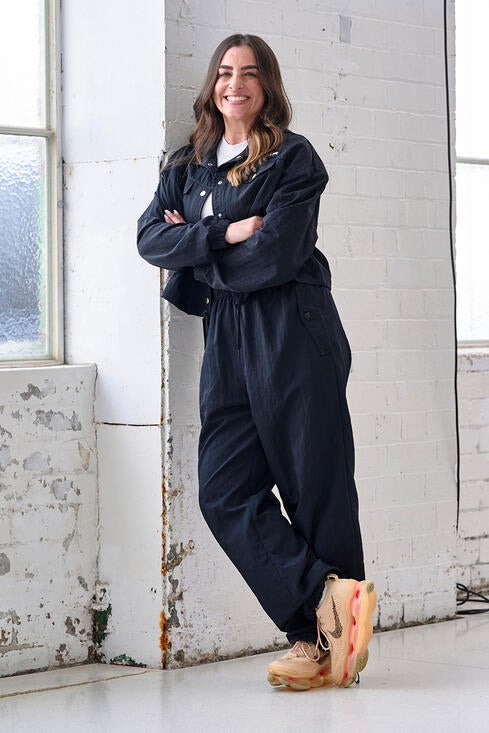ALUMNI PROFILE
Finding Her Footing
Nike executive Jordie Katcher is helping redefine women’s sports apparel on the world stage
By J.D. Mathes
A s a young girl growing up in Walnut Creek, California, Jordie Katcher remembers most of her friends hanging posters of athletes and actors on their bedroom walls. Katcher, on the other hand, carefully hung clothing labels. The daughter of two educators, she’s not sure where her love of fashion came from, but following clothing trends has been a lifelong passion — one that led to her becoming vice president of Women’s Global Sport Apparel at Nike.
The path to becoming an executive at one of the world’s top sportswear brands wasn’t always clear. When it came time for college, Katcher considered a fashion major, but worried her interest might wane and instead decided to study business. She toured several campuses but quickly knew UCR was the right school for her.
“The tour guide seemed to know everyone we passed by. People smiled and waved at each other,” she said. “From then on, I had an immediate feeling of community at UCR — something I didn’t feel from any other school.”
While At UCR, Katcher joined the Kappa Kappa Gamma sorority, participating in service projects and forming lifelong friendships during what she calls an “unforgettable” time. She graduated in 1996 with a bachelor’s degree in business administration and a minor in psychology.
“I found my voice at UC Riverside — an inner confidence that has served me well throughout my career,” she said.
Following UCR, Katcher joined the Macy’s Store Management Executive Development Program, an intensive 2-year program where she learned from the ground up about staffing, visual displays, inventory management, customer service, managing a workforce, and mining consumer insights. She then went on to work for the corporate arm of clothing retailer Gap Inc. in San Francisco.
“A highlight of my time at Gap was being part of the team to launch Old Navy in Canada,” she said. “We opened 13 stores in one day within the greater Toronto area. Thinking back, this was such a fond memory.”
During her five years at Gap, Katcher married her husband, Barry. She smiles when recalling how Barry found and submitted an application for the position at Nike in Portland for her — where she has now been for two decades (and counting).
In 2020, Katcher stepped into the role of vice president of Women’s Global Sport Apparel at Nike. Her team’s mission was to create uniforms and outfits for all the athletes across their vast portfolio of women’s sports, including developing the innovative kits used by footballers in the 2023 FIFA Women’s World Cup. The international football tournament, which saw record-breaking global viewership in the multimillions last summer, was the first event she worked on with her team.
“I still have to pinch myself that this was part of my job,” she said.
According to Katcher, each project begins by listening to the athletes. It’s a collaborative process that includes athlete and coach insights as well as partnership with the federations themselves, who approve the final designs.
“We spoke to professional footballers across the world to design the kits for World Cup ’23,” she said. “We had a few goals when we set out on this project: to challenge status quo every step of the way, innovate to remove every distraction possible, and make these athletes look and feel amazing.”
With only 6% of sports studies focusing on women, innovating at this scale was a challenge. In response, Nike restructured its business model to allow for a concentrated focus on women, she said.
“My role in Global Sports Apparel was an example of that — the increased focus was backed by Nike’s largest investment in women yet,” Katcher said. “We doubled the volume of women-specific sport science, expanded our insights teams focused on women and girls’ research, and grew our sports marketing offense to support our athletes in this space.”
Nike also invested in scanning technology to better understand athletes’ bodies in motion. These investments led to the most data-informed kits Nike has ever created, including using 4D heat mapping to determine where extra ventilation or support is needed and incorporating ‘Dri-Fit’ technology to ensure breathability and fast sweat evaporation. The resulting kits were worn by the U.S. women’s national soccer team and 12 other countries competing in the Women’s World Cup.
Katcher has since transitioned to vice president of Global Kids Apparel, where she plans to use the experience from her previous role to serve the next generation of athletes.
“I’m especially excited to explore opportunities to better understand and serve teen girls,” she said. “We know that girls are dropping out of sports at twice the rate of boys. While there are many factors that contribute to these statistics, many cite changes in their body as their number one drop-out reason.”
Katcher is most proud of the development of “Nike Leak Protection: Period,” an ultra-thin, absorbent liner built into the Nike One short to help protect against period leaks, which she said will have a positive impact for generations of athletes. The technology, which also debuted in the Women’s World Cup as part of the kits’ base layer, helps eliminate distractions and allows athletes to focus on the game.
On the horizon, Katcher is looking forward to seeing her contributions to women’s sports apparel “come to life in the Paris 2024 Olympics.”
“I plan to continue to challenge myself and make a positive impact wherever and however I can,” she said. “This includes helping those younger in their careers to find their voice and footing.”
Return to UCR Magazine: Spring 2024
